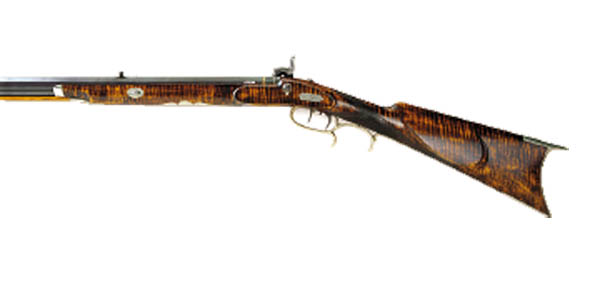THE LANCASTER LONG RIFLE
In some ways the story of the Lancaster long rifle is the story of Pennsylvania. It begins with unprecedented migration into Pennsylvania spurred on by William Penns generous offer to central Europeans to join in the development of a new nation and a new freedom. A converted Quaker, Penns vision for his new colony was for a benevolent society developed by a complex policy of rigid conditions and regulations aimed at future expansion. Migrants from Europe entered the port of Philadephia and quickly settled communities in Germantown, Reading, and Lancaster.
Although politically connected to Philadelphia and growing as a cultural and commercial center, Lancaster in the early 18th century was still a frontier town - a major crossroad to further undeveloped areas. The roads west from Philadelphia came directly to Lancaster and Reading, but unlike Reading, Lancaster offered routes, mostly Indian trails, south to Maryland and the Shenandoah Valley. From Lancaster, rough roads and a turbulent Susquehanna River crossing at Wrights Ferry challenged even the hardiest wanderer heading west. Heading south through an expanse of German and Swiss held farmland, trails connected to the head of the Chesapeake Bay. As a result, Lancasters strategic gateway location became the primary force behind the establishment of the most active and productive gunmaking industry in Pennsylvania. The countys seemingly endless supply of iron and limestone deposits, and vast forests with fast streams for water power, brought together the necessary elements to support the active gunmaking community.
As early as the 1700s Lancaster had a reputation as a town offering gunsmiths services and an assortment of supplies. While traveling the colonies in 1754, the Provincial Governor of the Massachusetts Bay Colony, Thomas Pownall, said in his famous journal:
I took the road from Philadelphia to Wright's Ferry, on the Susquehanna. Lancaster is a growing town, and making money - a manufactory is here of guns.
The very earliest, wealthy immigrants may have brought the Bavarian hunting rifle, the Jaeger, to their new homeland, but it proved to be the wrong tool for Pennsylvanias pioneers making long treks into the wilderness. The Jaeger had a short range, was slow to load, and heavy. The large amount of gunpowder required for its large bore and the subsequent weight of the lead balls made it impractical to carry any distance. The Jaeger rifle was generally around .70 caliber and could weigh fourteen or fifteen pounds.
What the frontiersman needed was a lighter rifle, weighing around ten pounds, with a smaller bore not much larger than .50 caliber, thus reducing the weight of the ball and the amount of gunpowder to be carried. The Pennsylvania gunsmiths calculated that a small bore with higher velocity could kill just as easily as a larger bore, and if the barrel was lengthened, it would significantly increase the range. Furthermore, the game Pennsylvanians could expect to encounter would not be the charging wild boar the Jaeger rifle was designed to kill with its large, hard hitting ball. To speed the loading procedure with the longer barrel, the Pennsylvania gunsmiths discovered that ramming the ball down the barrel with the aid of a small, greased patch shortened the time to load; and in turn, allowed less pressure to escape around the ball. This significant innovation by a Pennsylvania gunsmith was of the greatest importance to the functionality and efficiency of the long rifle. They also redesigned the patch box to hold the greased patches inside a hinged brass lid, eliminating the earlier sliding wood cover, which was apt to be lost. Little did they know that the brass patch box would become the individual statement of each gunsmith - an American feature which often identifies the gunsmith.
When word spread that the gunsmiths were producing this unique rifle, better suited to the Pennsylvania environment, the frontiersmens first choice quickly became the long rifle. English and French style smoothbore fowlers from Europe might be found, but the fowler was not as effective as the rifle for all game. It was logical to buy a rifle in Lancaster where larger communities of gunsmiths offered a broad variety of styles and prices. Ironically, during most of the 18th century, Philadelphia had fewer gunsmiths than the frontier towns of Reading or Lancaster, until the American Revolution when musket production began. The lack of rifle making in Philadelphia prior to the war was partly due to its large Quaker population with their pacifist leanings.
The Lancaster Long Rifle Exhibit currently on display at the Landis Valley Village & Farm Museum through December of this year features over sixty of the finest Lancaster made rifles, fowlers, and pistols that have survived for almost three hundred years. The primary goal of this collection is to impart the artistic features of the Lancaster County long rifles - the exquisite carving and elegant form of function Lancaster gunsmiths were able to achieve when creating their best guns. To complete the story, foreign transitional firearms, plain Indian trade guns, and those made by the famous Leman Factory are included in the Exhibit. The Exhibit includes rarely seen examples from institutions and private collections, including sixteen rifles from the famous Kindig collection. Ironically, given the fame of the Lancaster rifle and its highly extolled history, the Landis Valley Exhibit is the first comprehensive exhibit of Lancaster County firearms ever held.
A full color, hardbound book accompanies the Exhibit and is available from Eastwind Publishing - (410) 476-4445 or eastwind@hughes.net.
Note: A special long rifle weekend will be held at the Landis Valley Village & Museum on July 21st and 22nd where gunmaking displays, shooting events, and seminars on the long rifle history will be held. On Saturday, July 21st, Patrick Hornberger and John Kolar, Guest Curators of the Exhibit, will appraise muzzle loading rifles (pre 1850) brought in by the public. Call (717) 569-0401 for further information.

Amanda Jean & Laura Mae Hornberger
Amanda Jean and Laura Mae Hornberger are co-owners of www.maejeanvintage.com based in Lancaster, Pa.

















